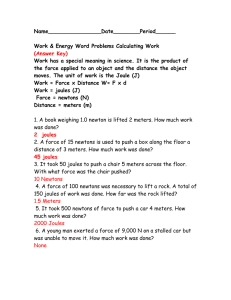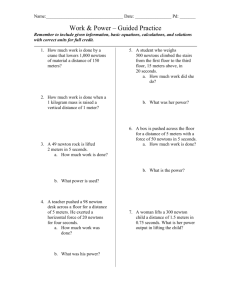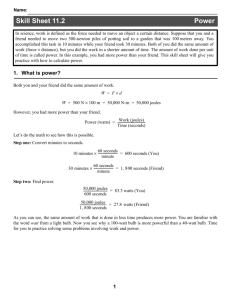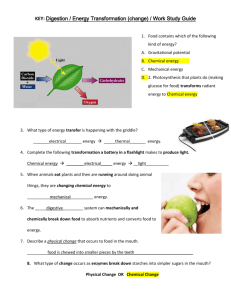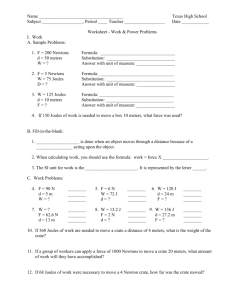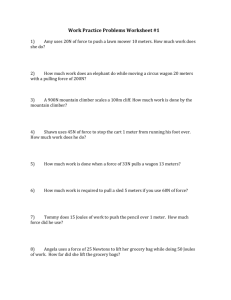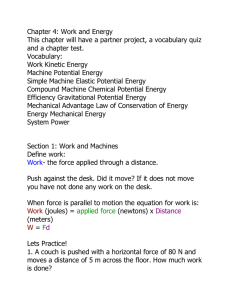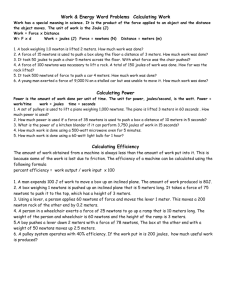POWERPOINT JEOPARDY
advertisement
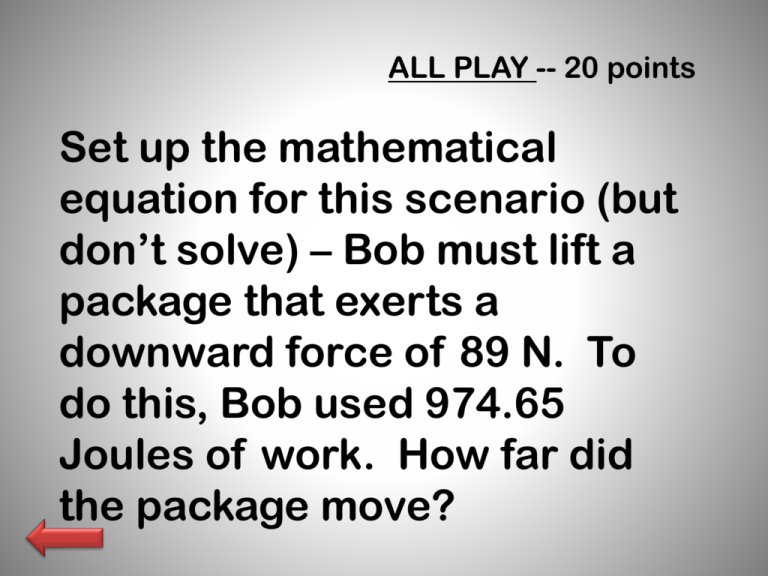
ALL PLAY -- 20 points Set up the mathematical equation for this scenario (but don’t solve) – Bob must lift a package that exerts a downward force of 89 N. To do this, Bob used 974.65 Joules of work. How far did the package move? 974.65 = 89 x d Question 1 for -- 10 points For work to have been completed, what must have happened? It moves Question 2 for -- 10 points A force of 15 Newtons is used to push a box along the floor a distance of 3 meters. How much work is done? 45 Joules Question 3 for -- 40 points If it requires 200 Joules to move an object 25 meters, how many Newtons was the object applying? 8 Newtons ALL PLAY -- 50 points Explain how chromosomes, genes, DNA, traits, and nucleus are all tied together. Chromosomes are found inside the nucleus. DNA makes up the chromosomes. Genes are found on the DNA and traits are coded for by the gene segments. Question 4 for -- 30 points Simple machines make work easier, but they do not change the amount of work that must be completed. If the work stays the same and the force applied decreases (so it’s easier), what happens to the distance? increases Question 5 for -- 70 points Kamryn and Julia move a box a distance of 500 meters. The box exerts a force of 3 Newtons. How much work do each of the girls have to do to do this if they share the task equally? 750 Joules Question 6 for -- 30 points A 500 Newton mountain climber scales a 100 meter cliff. How much work is done? 50,000 Joules Question 7 for -- 25 points The weight of a German shepherd puppy was measured each month from birth to six months. Using a line graph is the best way to represent the growth of the puppy? Which variable would belong on the x-axis? Time (months) ALL PLAY – for 30 points Set up the equation for the following scenario: Dave uses 280 Joules to move an object 20 meters. How many Newtons had to be applied to do this? 280 = F * 20 Question 8 for -- 40 points A girl is carrying her 250 N cat and walks 12 meters into the next room. How much work is done? 3000 Joules Question 9 for -- 25 points What is the function of the mitochondria in our cells? Which body system would we use to compare the function of this organelle? Energy within the cell – digestive system Question 10 for -- 20 points Mrs. Stoddard measured the speed of light in different materials at 100ºC. The data is shown in the table. Which material had light travel through with the fastest speed? Material State Speed (m/sec) Silver Gas 1248.3 Water Liquid 879.478 Prism Solid 1400 Gold Solid 1019.12 prism ALL PLAY - 20 points Does Kobe Bryant have bigger cells than me since he is taller than me? Explain No – just has more cells since he’s bigger Question 11 for -- 40 points In genetics, a trait that shows up is called a ________ trait while a hidden trait that we cannot see is ______________. Dominant Recessive Question 12 for -- 10 points Who is considered to be the “father of genetics”? Mendel Question 13 for -- 25 points Simple machines work by ___________ the effort (force) that needs to be applied and by ___________ the distance that the object must move. Decreasing Increasing Question 14-- For 10 points: Force is measured in which unit? Newtons Question 15 for -- 20 points A group of similar cells make up a ________. Which work together to form a/an _________. Which, in turn, when placed together form a/an __________. Many of these work together to complete a/an ____________. Tissue Organ Organ System Organism ALL PLAY-- For 20 points Jeb is moving 2 identical boxes. He picks up one box and moves it 3 meters straight up. This requires 100 Newtons of force. He pushes the other box up a ramp that is 25 meters long; this requires how much force? 12 Newtons ALL PLAY for -- 25 points If Jayne uses 400 Joules to move an object 5 meters and Pam uses 1200 Joules to move the same object 20 meters, who has put in more effort into the task? How much force does each of the ladies apply? ** Jayne – 80 Newtons Pam – 60 Newtons Question 16 for -- 10 points Work is measured in which unit? Joules Question 17 for -- 40 points What is homeostasis. Which 2 body systems work together to make sure homeostasis is maintained? Equilibrium or stability; Endocrine & Nervous ALL PLAY for -- 15 points 1) What type of energy deals with movement? 2) What type of energy is found in food? 3) What type of energy is released from metabolizing food? 1. Kinetic 2. Chemical 3. Thermal/Heat Question 18 for -- 25 points What is the difference between the words: structure and function? Structure refers to the shape and function refers to the job Question 19 for -- 20 points What are 2 things that are different in a plant cell when comparing it to an animal cell? Plant cells have a cell wall and chloroplasts and a much larger vacuole Question 20 for -- 10 points During digestion, what is the physical change that occurs in the large intestine? Absorption of water Question 21 for -- 20 points Which scientist discovered animalcules while looking at gunk under the microscope? Leeuwenhoek ALL PLAY - 30 points ________ speed up chemical reactions in our bodies. Where in the digestive system are there no chemical changes taking place? Fats begin breaking down in the ____________, and proteins begin breaking down in the ________. 1. 2. 3. 4. Enzymes Esophagus Small Intestine Stomach Question 22 for -- 15 points Explain how balanced forces and work go together. Balanced forces have no movement; therefore NO WORK Question 23 for -- 20 points What are the difference between genotype and phenotype? Genotype is the letters; phenotype is the physical appearance ALL PLAY for -- 40 points How do the circulatory system and the respiratory system work together to help keep us alive? Circulatory system moves oxygen through the body while the Respiratory system brings it into the body Question 24 for -- 10 points Which system is responsible for fight or flight? Enodocrine Question 25 for -- 15 points What part of the cell is comparable to the skeletal system? Cell wall ALL PLAY for -- 30 points List the 3 parts of the cell theory. 1. All living things are made of cells. 2. The cell is the basic unit of structure and function in living things. 3. All cells come from preexisting cells. Question 26 for -- 10 points In order to keep work constant, if the force applied decreases, what happens to the distance? It increases Question 27 for -- 20 points List 3 characteristics of sexual reproduction. 2 parents Diverse offspring Able to adapt Question 28 for -- 30 points Sometimes we get a fever when we’re sick, what exactly does that mean? Immune system is fighting off the bad bacteria ALL PLAY -- 10 points When graphing stuff from an experiment, where do we graph the independent variable? Is this the one we measure or the one we change? X axis; we change it Question 29 for -- 10 points What word indicates “sexual” reproduction with plants/flowers? pollination Question 30 for -- 25 points What are the 6 functions of the skeletal system? Support Structure Movement Protect Store minerals Produce RBCs ALL PLAY-- 50 points Create 2 different situations where the same amounts of work are completed (work cannot = 0). (You must use a 2-digit number)
